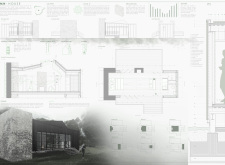5 key facts about this project
The micro house project offers a practical living solution designed for individual needs, located within the scenic region of Galicia, northern Spain. The design emphasizes self-sufficiency and sustainability, catering to residents who prefer a closer connection to nature as they adapt to new work patterns. Functionality is central to the concept, with a focus on maximizing space efficiency while ensuring comfort and ease of use.
Design and Functionality
At the heart of the micro house is an approach grounded in thermodynamic principles. The building features an elevated floor that is supported by three critical contact points. These include a dedicated service area with a kitchen, bathroom, and shower, all designed with independent drainage systems. A reused thermal inertia wall is a key feature, providing effective insulation against temperature fluctuations and contributing to the overall energy efficiency of the home. A chimney aids natural ventilation, ensuring a pleasant indoor environment.
Sustainability Features
Sustainability is a crucial element in the design. The stone wall acts as an important structural component, helping manage thermal comfort within the space. During warmer months, nearby deciduous trees offer shade that prevents overheating. Warm air rises and is expelled through an automated grid in the chimney, promoting air circulation and regulating temperature. In winter, the wall absorbs solar heat and gradually releases it, which keeps the indoor climate stable and comfortable throughout the night.
Integration of Local Context
The project connects closely with its geographical and cultural context. By reusing materials from abandoned buildings in the area, the design respects local history while addressing contemporary needs. The incorporation of coarse walls is not only functional but also enhances the aesthetic appeal. This approach highlights a commitment to sustainability while staying true to regional architectural traditions.
Water Management System
A rainwater collection system reduces reliance on external sources. The roof's slope directs rainwater into a storage tank beneath the house. This system allows for the harvested water to be used for various purposes, including generating electricity through the REGN system, promoting an eco-friendly lifestyle.
The design pays attention to detail with the use of materials like zinc for both the façade and rain gutter. These choices ensure durability and contribute to visual harmony. Proper insulation and vapor barriers within the metal framework enhance the home’s thermal performance. The design effectively combines modern living requirements with respect for the natural surroundings, resulting in a thoughtful living environment.


















































